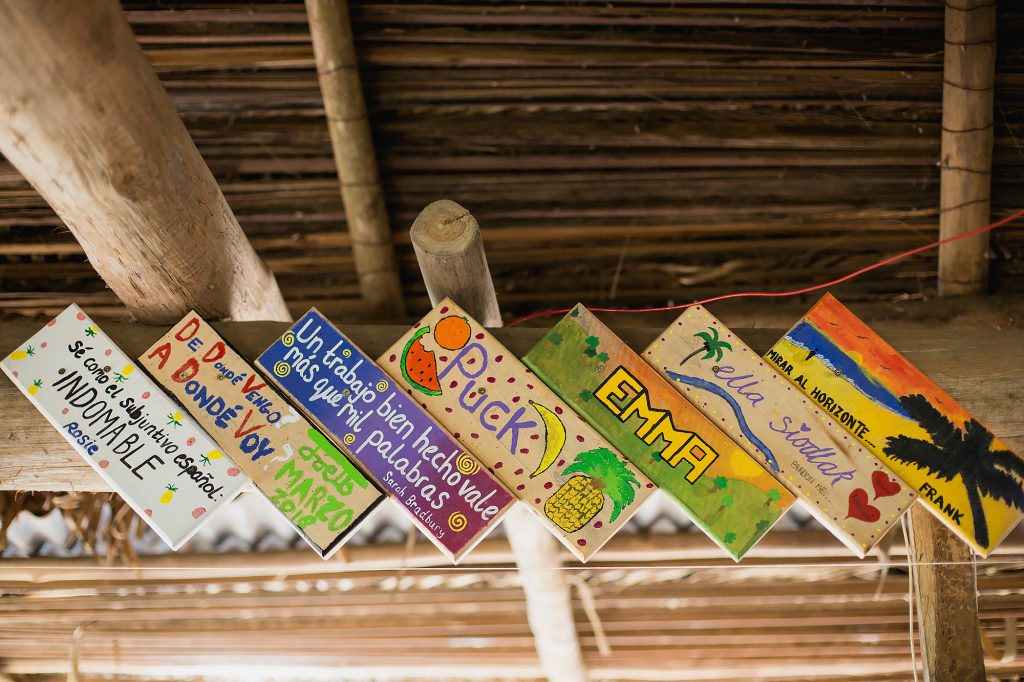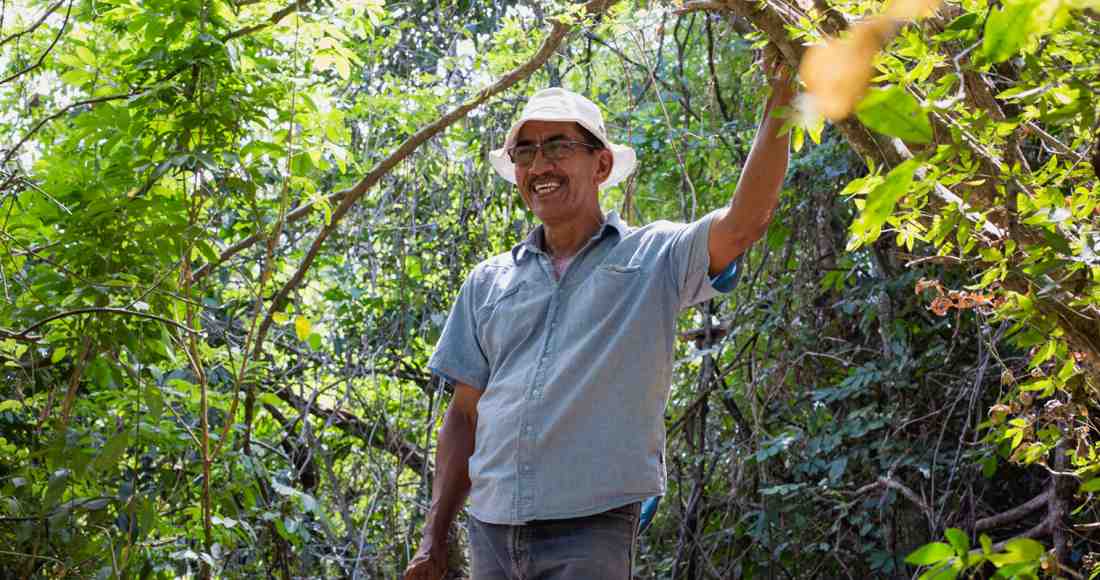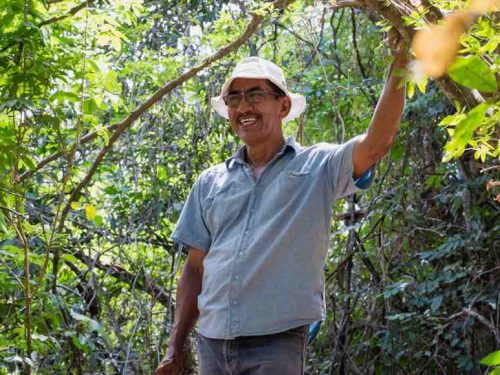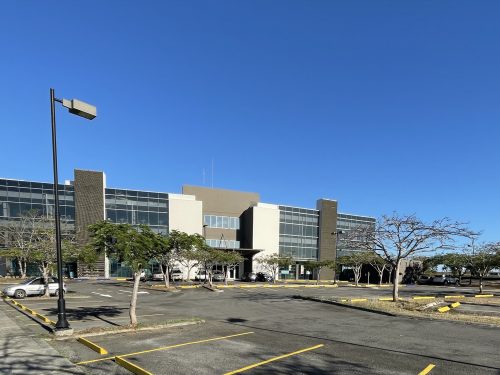
Ezequiel Aguirre is perched on a wooden structure in the shape of a house while he attempts, with all his effort, to hammer in a nail that doesn’t want to pierce the wood. “It’s too hard, too hard,” he tells Luke, a volunteer from Malta who is trying, without success, to help him in this mission.
It’s 9:15 am and the March sun is relentless. We are on a property located in the Matambú indigenous territory in Hojancha, Guanacaste. The trees around us help shade us a little from the heat. Ezequiel, a 65-year-old native Chorotega, and his family own these 50 acres of dry, tropical forest. Here, they are creating a cultural ecotourism project that includes trails, waterfalls and natural pools. The cabins that they are building now will host tourists in the future.
What they want to achieve is that here, on this project with their family, the young Matambú indigenous people can see an example of how strengthening the Chorotega identity and showing it to the world can yield many returns, including economic.
“Tourists should feel the family warmth, live alongside us, make a hammock, make a small, clay pot, try that which is ours,” he says. Perhaps this will help produce pride for indigenous identity instead of shame among the boys of the tribe, he explains to us with a twinkle in his eyes.

All of the Raleigh volunteers leave a memento on a table for Ezequiel and his wife, Gladys.
In order to understand Ezequiel’s passion, we must first understand that the Matambú indigenous people have suffered through severe discrimination, even within their own cantons of Hojancha and Nicoya and, above all, in the high schools that the young members attend. “Even though they don’t look different, they treated them badly just because they were from Matambú. It’s geographic discrimination,” anthropologist Karen Stocker explains to me. She has studied this community for more than two decades.
Ezequiel adds that the abandonment by the state ranges from the options for sending young kids to college to a lack of awareness of their culture as something that belongs to Guanacastecans.
Nonetheless, the traditions of the Chorotega indigenous people survive “inside the home, in their food, and in the most intimate settings,” Karen explains to me.
That’s how the home of Ezequiel and his wife Gladys is, just as Karen describes. From the outside, it looks like a common, run-of-the-mill house, but inside the fridge is a pot of cold chicheme (a traditional drink made from corn) that is usually served in cups called guacales made from hard calabash shell. In his workshop, Ezequiel uses clay from his yard to make Chorotega pots. On the inside, culture is preserved.
In The Genes
As he climbs down from the scaffolding, disappointed that the nail didn’t want to go in, Ezequiel explains to us that the wood he is using is from a breadnut tree that Hurricane Nate knocked down and that they wanted to make use of. “But I am already regretting it,” he says. He knows that later, he will try again.
His brother, José Vivian, says that Ezequiel is a naturally perseverant man. He was part of the second generation of indigenous people who graduated from high school, he was regional director for the Costa Rica postal service, he’s a business administrator, former president of the National Indigenous Council and, now, a craftsman and founder of this ecotourism project.
When he started working at the Nicoya central post office, he began to learn to type and started to take other courses. His boss refused to give him an office job, so he was transferred to San Jose where he began moving up the chain of command until he became director of the Guanacaste regional headquarters. More than two decades later, he left in order to make marimbas and pots.
“He built the pottery wheel himself,” José Vivian tells me proudly. “Don’t think for a second that he bought it.”
José Vivian adds that what Ezequiel is doing now with the ecological project is very unique because many have wanted to, but none persevere.
The people, however, seem to be gaining the same awareness that this family has about their identity and culture.
For example, José Vivian is the principal of the Matambú school and assures that, along with the program Guanacastequidad, the children’s sense of their cultural identity has begun to strengthen.
Pedro Pablo, another one of José Vivian and Ezequiel’s brothers, has led a few tours through the property since 2012. He also has a locale that serves food made from corn and is included in the ecological project. Other small-scale agricultural and ranching initiatives have joined the Aguirre family proposal.
What do these brothers have in their genes? According to Ezequiel, his father was very smart and he taught them to combine agricultural activities with the forest. “We learned to rotate the crops so that we don’t wear out the land,” he explains to us. “Some 50 years ago we took the livestock out and we started to reforest the whole property,” he adds.
An Indigenous Man of the World
After taking us along the trails and to the waterfall, we stopped by Nemú Nekupe (which means paradise in the Chorotega language), the ranch where volunteers from the international organization Raleigh live. Ezequiel and Gladys attend to them everyday.
Luke, the Maltese, is part of the second group to arrive at the property to help build the trails, move the logs that fell during the last storm and lend a hand in whatever is left to do. “They are really good guys,” Ezequiel tells me. Sometimes he is surprised by the customs of young Europeans. “When you realize, they come out of the bathroom in underwear,” he says, laughing with Gladys.
He says it with a hint of sweetness in his voice, because he has grown affectionate of them and because what he wants for the future of his property and of Matambú is for many foreigners to be part of the family, so they can get to know the Chorotega culture and help make it grow.






Comments